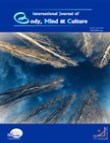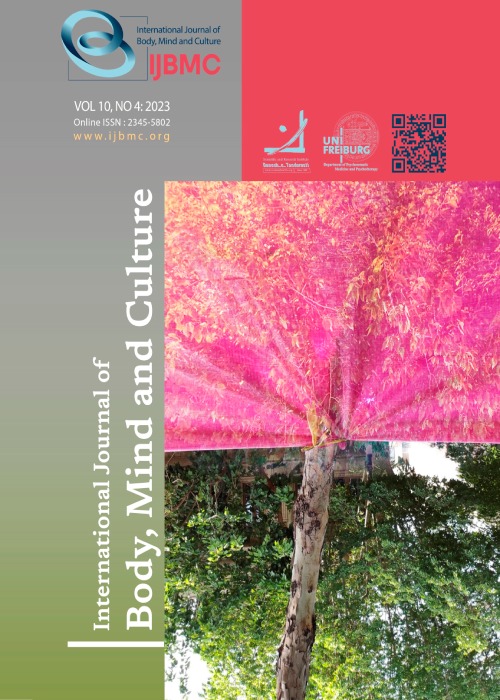فهرست مطالب

International Journal of Body, Mind and Culture
Volume:7 Issue: 1, Winter 2020
- تاریخ انتشار: 1398/11/26
- تعداد عناوین: 8
-
Pages 3-7
Any changes in a human’s life, either pleasant or unpleasant, require re-adaption. Coping strategies for life changes and tensions caused by these changes differ in different people in various situations. Diabetes mellitus (DM) is one of the highly prevalent stressful diseases. At present, the prevalence of diabetes has been estimated to be 4% throughout the world, and it is expected that this rate will increase to 4.5% by 2025...
-
Pages 8-14
The Coronavirus epidemic has become a pandemic. The induced crisis has had a global impact. Moreover, there is an uncontrollable interplay between the coronavirus, panic as an emotional virus, viral communication, and the economic and political borderline experience. The world is facing an unprecedented factual and psychological challenge. People are therefore seeking emotional orientation and protection above all in their own group, family, close friends, and nation. However, this often leads to radical dissociation from other groups or nations. This functions in the sense of a psychological defense as a group and is a normal process during an epidemic. In the past two decades, globalization has focused on boundless performance and efficiency increase. In doing so, it has not sufficiently taken people into account; one could say that globalization does not respect humans as humans. It is in danger of succumbing to a narcissistic fantasy of omnipotence. The current virus crisis is holding up its own mirror to the world. It therefore functions as a psychological disillusionment that seems to have the entire world under control. People and nations feel the limits of what is possible. They experience their powerlessness and fall into a state of panic that seems to paralyze people. There is no doubt that medical, economic, and political action is absolutely necessary. A far greater challenge is to reach people with their very own concerns and needs. This cannot be achieved through political war rhetoric. It can only be done if people and nations become aware of the competence of ambiguity tolerance. This, combined with the development of an experienceable and visible sense of community, strengthens resilience, namely, one's psychological resistance.
Keywords: Virus Crisis, Globalization, Panic, Narcissistic Omnipotence, Resilience, Tolerance Of Ambiguity -
Pages 15-17
Health is enigmatic in nature, in the sense that people pay attention to it when they have lost it. This enigmatic nature of health is the context for expressing health-related paradoxes. The paradoxes of digitalization, isolation, and prevention that have become prominent in the COVID 19 pandemic are elaborated in this article. The digitalization paradox demonstrates that we have procrastinated in digitalizing daily life, but have the digital tools to communicate with others and share information in quarantine. The isolation paradox means that "social distancing" is required to prevent infection, but loneliness can make us sick. The "paradox of prevention" arises when reducing the risk of persons in medium-risk to low-risk groups has a greater impact on the overall risk in the population than only reducing the risk of persons in high-risk groups. All three paradoxes reflect the complexity and uncertainty of circumstances in a pandemic and the need for medical humanities.
Keywords: COVID 19, Health Related Paradox, Medical Humanities, Digitalization Paradox, Isolation Paradox, Prevention Paradox -
Pages 18-26Background
Mental health in the middle-age period is vulnerable due to the many biological, physical, psychological, and social changes, and the consequences of these changes. Women experience more changes and complications associated with aging in this phase of life than men. The aim of the present study was to determine the relationship of early maladaptive schemas and Big Five personality factors with impulsivity.
MethodsThe present study was a correlational research. The study population consisted of all middle-aged women in regions 1 and 2 of Tehran, Iran. From among them, 150 were selected through randomized cluster sampling. Subjects completed the Big Five Inventory-2 (BFI-2), Dickman's Impulsivity Inventory (DII), and the Young Schema Questionnaire-Revised (YSQ) before and after the intervention. To analyze the data, descriptive statistics (mean and standard deviation) and inferential statistics (the Pearson correlation coefficient and multiple regression) were used in SPSS software.
ResultsCorrelation analysis indicated that all domains of early maladaptive schema had a significant positive correlation with impulsivity (P < 0.01). Impairment limitations (Beta = 0.45; t = 33.8), self-regulation and impaired function (Beta = 0.42; t = 27.44), and disconnection and rejection (Beta = 41.0; t = 25.83) were able to predict 78% of impulse variance (R2 = 0.78; F = 7122.63; P < 0.0001).
ConclusionThe results showed that early maladaptive schemas and Big Five personality factors were significant predictors of impulsivity. Impaired limits, self-regulation and impaired performance, and disconnection and rejection were the strongest predictors of impulsivity.
Keywords: Early Maladaptive Schemas, Big Five Personality, Impulsivity, Middle-Aged Women -
Pages 27-36Background
The objective of the present study was to determine the effectiveness of self-compassion training on self-discrepancy, sense of loneliness, and adaptation after divorce among women.
MethodsThe present quasi-experimental study was conducted with a pretest-posttest design and a control group. The statistical population consisted of all divorced women referring to counseling centers in district 2 of Tehran, Iran, between April and June 2019. From among them, 30 individuals were selected through convenience sampling method and randomly divided into experimental and control groups. Data were collected using the Fisher Divorce Adjustment Scale (Fisher, 1976), self-discrepancy questionnaire (Higgins, 1987), and Revised UCLA Loneliness Scale (Russell, Peplau, & Cutrona, 1980) and analyzed using univariate analysis of variance and multivariate analysis of covariance in SPSS software.
ResultsThe self-compassion-based therapy reduced self-discrepancy and feeling of loneliness, and improved post-divorce adaptation in the experimental group.
ConclusionIt can be concluded that self-compassion-based therapy is effective on self-discrepancy, feeling of loneliness, and adaptation after divorce in women.
Keywords: Self-Compassion, Self-Discrepancy, Loneliness, Post-Divorce Adaptation, Women -
The Association between Stress and Illness Anxiety during the Corona-Virus Outbreak in China in 2019Pages 37-43Background
The Corona-virus (COVID-19) outbreak in China in 2019 can cause psychological traumatic reaction; it can be a risk factor for illness anxiety. The predictors of severe illness anxiety have not yet been explored.
MethodsThe present research was a cross-sectional study. The Impact of Event Scale-Revised (IES-R) was used to evaluate stress reaction, and Whiteley Index-7 (WI-7) was applied to measure illness anxiety. Participants with scores above the median WI-7 score were categorized as severe illness anxiety and those with scores lower than the median WI-7 score were categorized as non-severe illness anxiety. Logistic regression was used to calculate the odds ratio (OR) and 95% confidence interval (CI). Stress level was divided into mild, moderate, and severe, which were included in the logistic model to estimate the association of stress and illness anxiety.
ResultsAfter adjusting for covariates, the OR of mild, moderate, and severe stress reaction level was 3.32 (95% CI: 2.21, 4.99), 6.01 (95% CI: 2.99, 12.05), and 14.54 (95% CI: 7.99, 26.47), respectively. The P for trend was less than 0.001 across the levels of stress reaction.
ConclusionSevere stress reaction has been associated with severe illness anxiety during the outbreak of COVID-19 in China. The corona crisis intensifies the experience of personal stress that in turn increases the fear of the COVID-19 illness in China. Further qualitative and follow-up studies are essential to illustrate the development of illness anxiety.
Keywords: Stress, Anxiety, COVID-19 Outbreak -
Pages 44-47
The Institute for Humanities and Cultural Studies (IHCS), Tehran, Iran, recently arranged a webinar on 8th of May 2020 entitled the "dialogue between medicine and humanities on corona pandemic". This webinar was part of the ongoing activities entitled the "cultural and social aspects of corona epidemic in Iran" in which a large number of scholars were invited to reflect on the social and cultural aspects of the corona pandemic. The speakers of this session included Hamidreza Namazi and Alireza Monajemi. The webinar consisted of two separate lectures and a debate. The following articles report the main results of this meeting.


